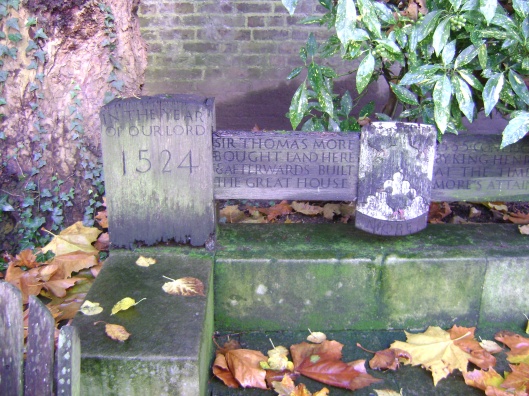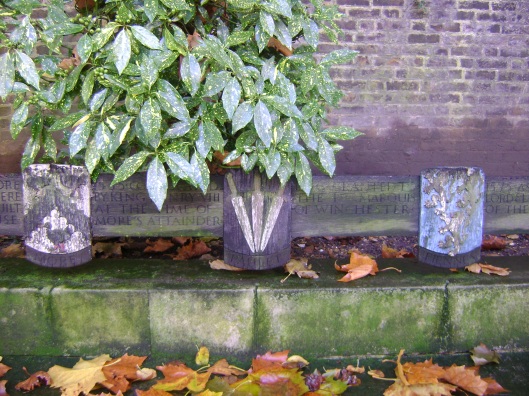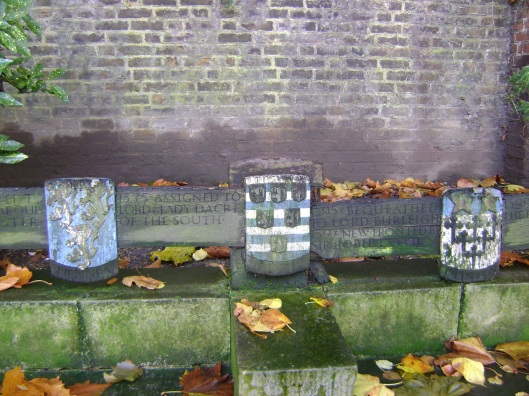Tags
The unobtrusive entrance to the Moravian burial ground can be found in a quiet corner of Chelsea, on Milman’s Street, more or less on the corner with King’s Road. The Moravians had had their meeting room in the City at Fetter Lane since 1742 and continued to use it till an air raid in World War II destroyed the building. In 1750, the brotherhood bought a large plot of land in Chelsea in order to realise their ideal of a dedicated community which was to have the name “Sharon”, but unfortunately, the money ran out and most of the land had to be sold off again in 1774. What remained is the small site of the burial ground with a few buildings, known as Moravian Close.

Beaufort House, drawn by Kip in 1708 for Britannia Illustrata with Beaufort House in the centre of the picture, Lindsey House bottom left, Gorges House between the two and the stable blocks beyond the main house on the left
The money to buy the large piece of land in Chelsea came from Count Nicholas Ludwig von Zinzendorf, the head of the Brethren of the Moravian Unity (see for more on him here), but as foreigners were not allowed to own land, it was purchased in trust for the Moravians by various wealthy supporters. The occupation of the original plot of land (stretching from the river to King’s Road) had started in 1524 when Sir Thomas More built a house there surrounded by large gardens and orchards. The Moravian burial ground is situated on what used to be the stable blocks in the northwest corner of the estate. After More was found guilty of treason and executed in July 1535, the estate was granted to Sir William Paulet, the first Marquess of Winchester who had been one of the judges in More’s trial. It was inherited by his son John, the second Marquess. It then passed to Gregory Fienness, Lord Dacre, and his wife Anne who left it to Lord Burleigh and hence to his son Sir Robert Cecil.
In 1599 the house was sold to Henry Clinton, second Earl of Lincoln, and then passed to his son-in-law Sir Arthur Gorges who sold it to Lionel Cranfield, the Earl of Middlesex. Cranfield fell out with Charles I and his property was confiscated and granted in 1627 to George Villiers, first Duke of Buckingham. In the Civil War, the house was seized by Parliament, and although the second Duke of Buckingham regained it, he lost it again through debts. It came into the hands of George Digby whose widow sold it in 1682 to Henry Somerset, Marquess of Worcester, later 5th Duke of Beaufort. The house then became known as Beaufort House. The last owner was Sir Hans Sloane who had the building demolished. In the two centuries between the building of the original house for Sir Thomas More and its destruction by Sir Hans Sloane, the house had been modified and enlarged several times and other houses had been built in the grounds, such as Lindsey House and Gorges House.
The buildings that are now on the Moravian site have been transformed several times. In the nineteenth and early part of the twentieth century, the larger building in the centre of the row of buildings on the north side of the grounds was used by various other organisations; at one time it was a school. The smaller building on the east side was retained by the Moravians as a chapel for burial ceremonies. On the centre building a plaque can be found commemorating Christian Renatus von Zinzendorf, the son of the founder (more on him here). His burial registration refers to the burial ground in Milman’s Street as “Sharon”.
The burial ground itself is divided into four sections: two squares for single and married sisters and two squares for the single and married brethren. The gravestones lie flat on the ground and only have name and dates of birth and death. The Close is a conservation area and the buildings are Grade II listed. Across from the burial ground a pergola can be seen which was set up by sculptors Ernest and Mary Gillick (see here and here) who leased the site from the Moravians from 1914 to 1964. After they left, the Fetter Lane community who had been using various other chapels after their own was destroyed in 1941, decided to relocate to Moravian Close.
The Gillicks were also responsible for the heraldic shields above the stone bench along the south wall. They represent the former owners from Thomas More to Hans Sloane.
The site is open to visitors on Wednesday afternoons and – at least when I was there – is a very pleasant and quiet green space, away from the hustle and bustle of Chelsea.
—————-
The information on the history of Beaufort House came from the Survey of London, vol. 4, The Parish of Chelsea II (1913) and information on the burial ground from A Feasibility Study for Moravian Close, 281 Kings Road, Chelsea, London (2003).
Website of the Church: www.moravian.org.uk.












Fascinating and very informative . One correction . Henry Somerset became the 1st Duke of Beaufort not the 5th.